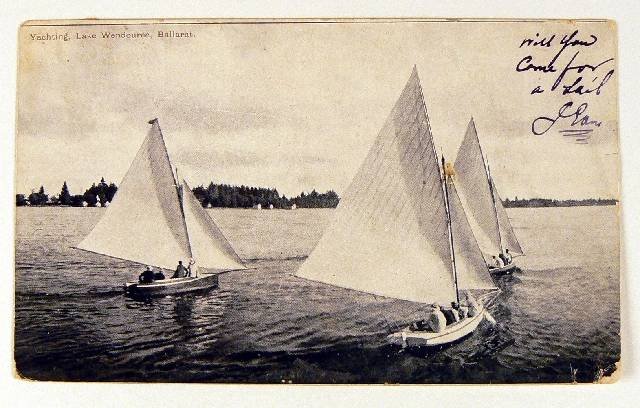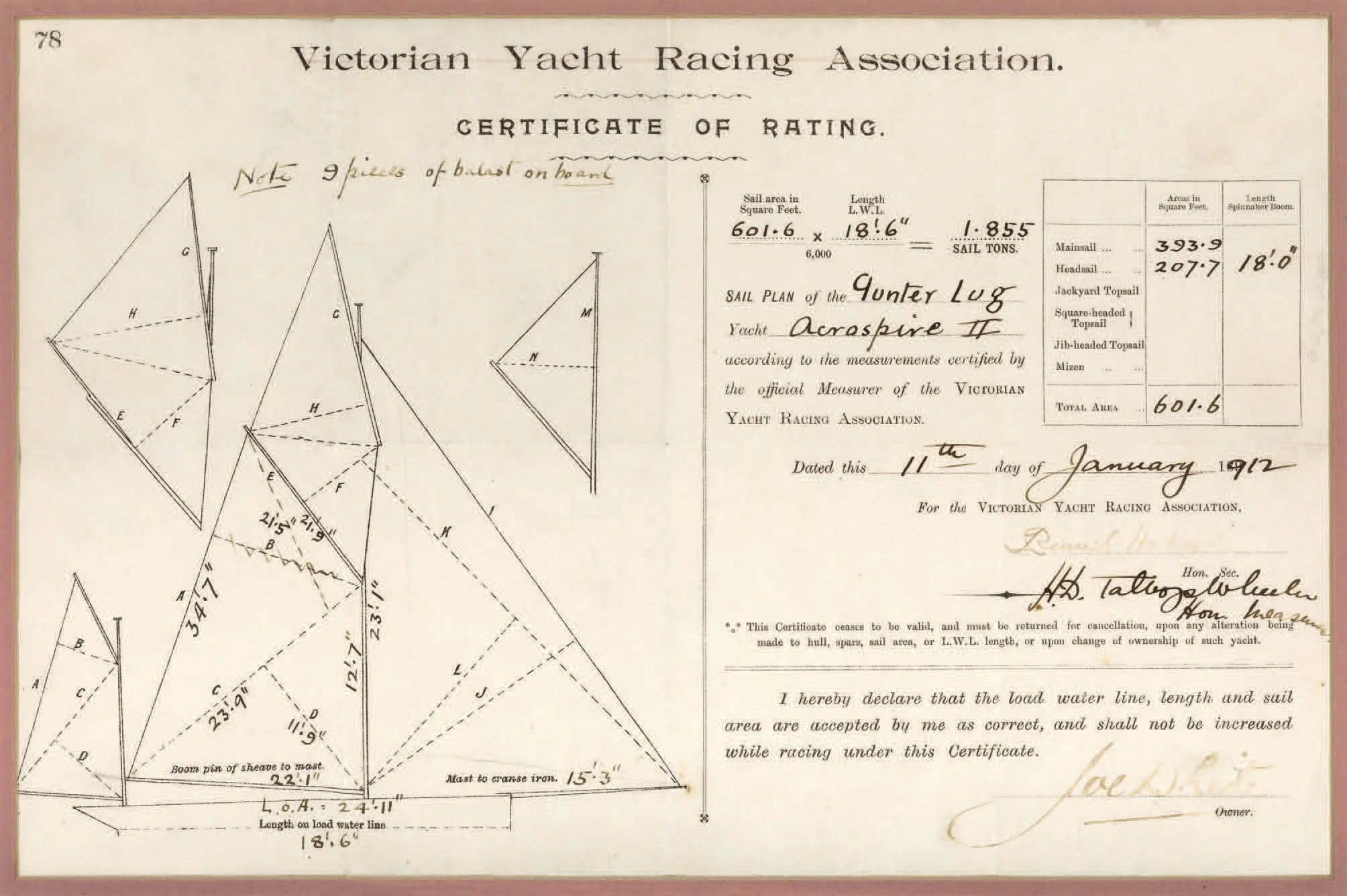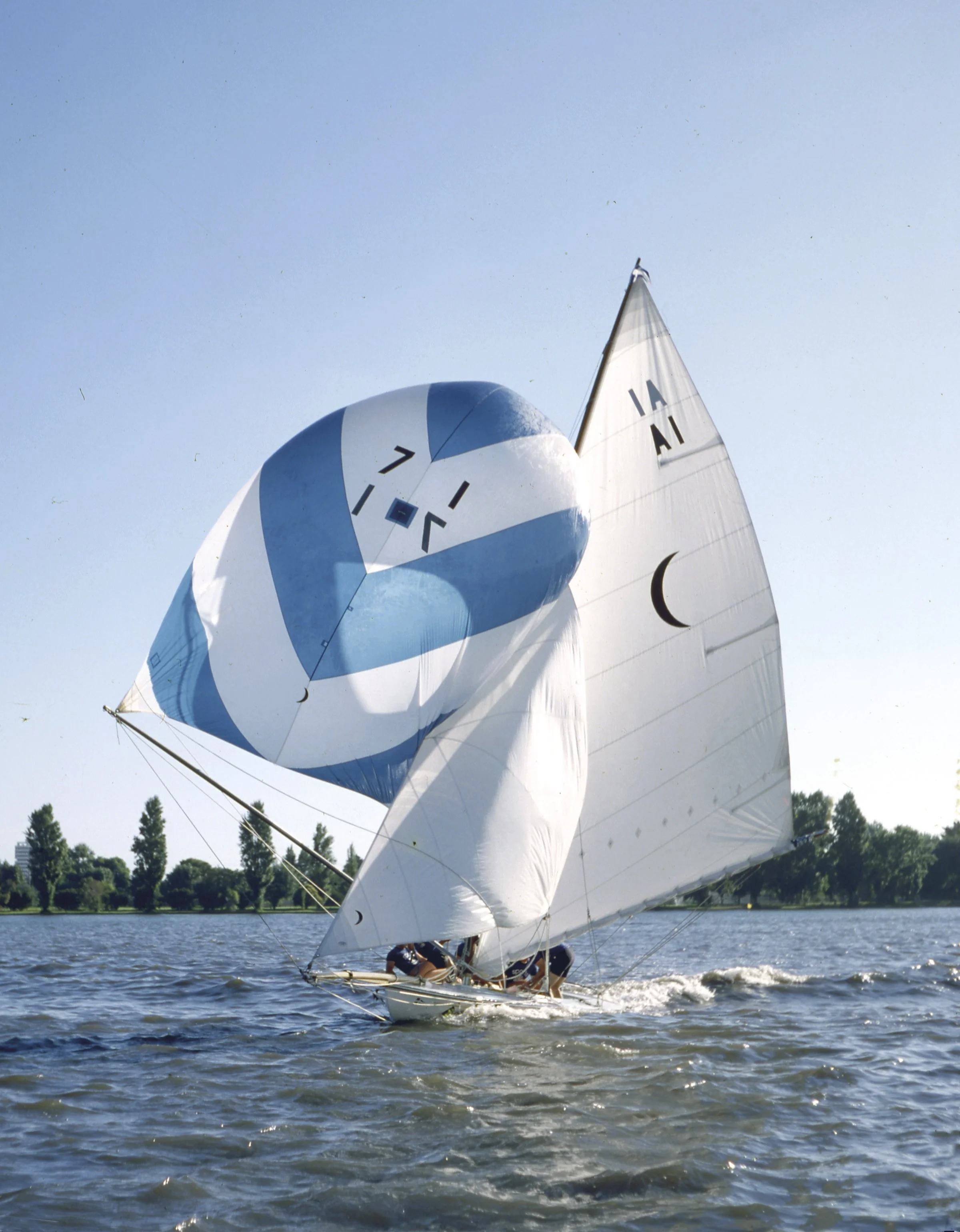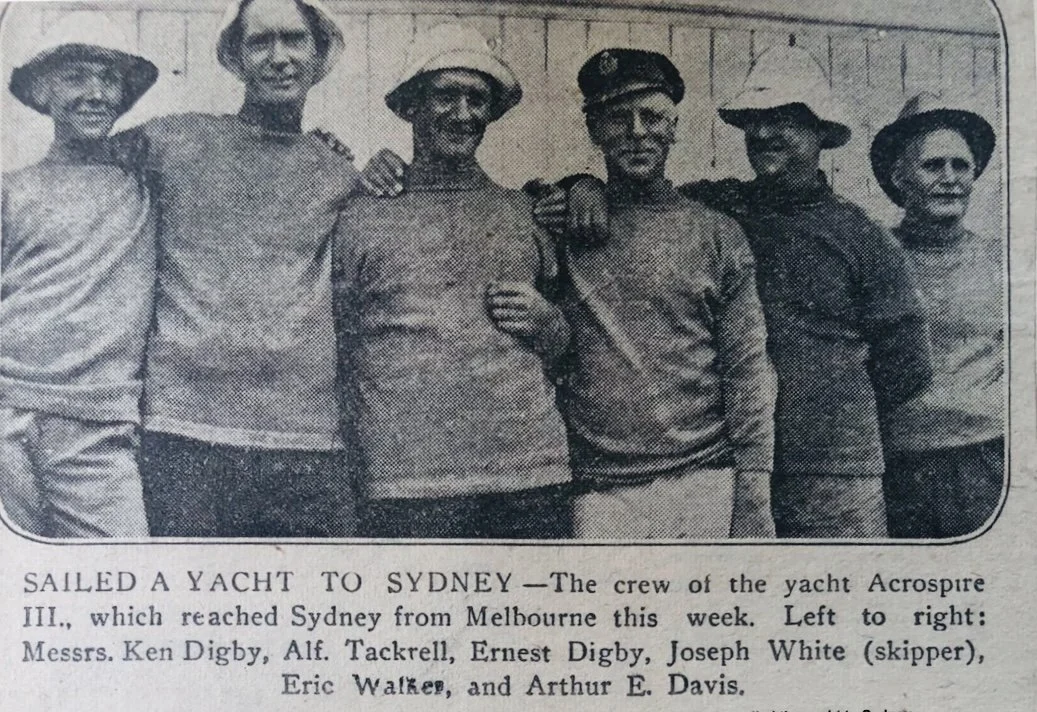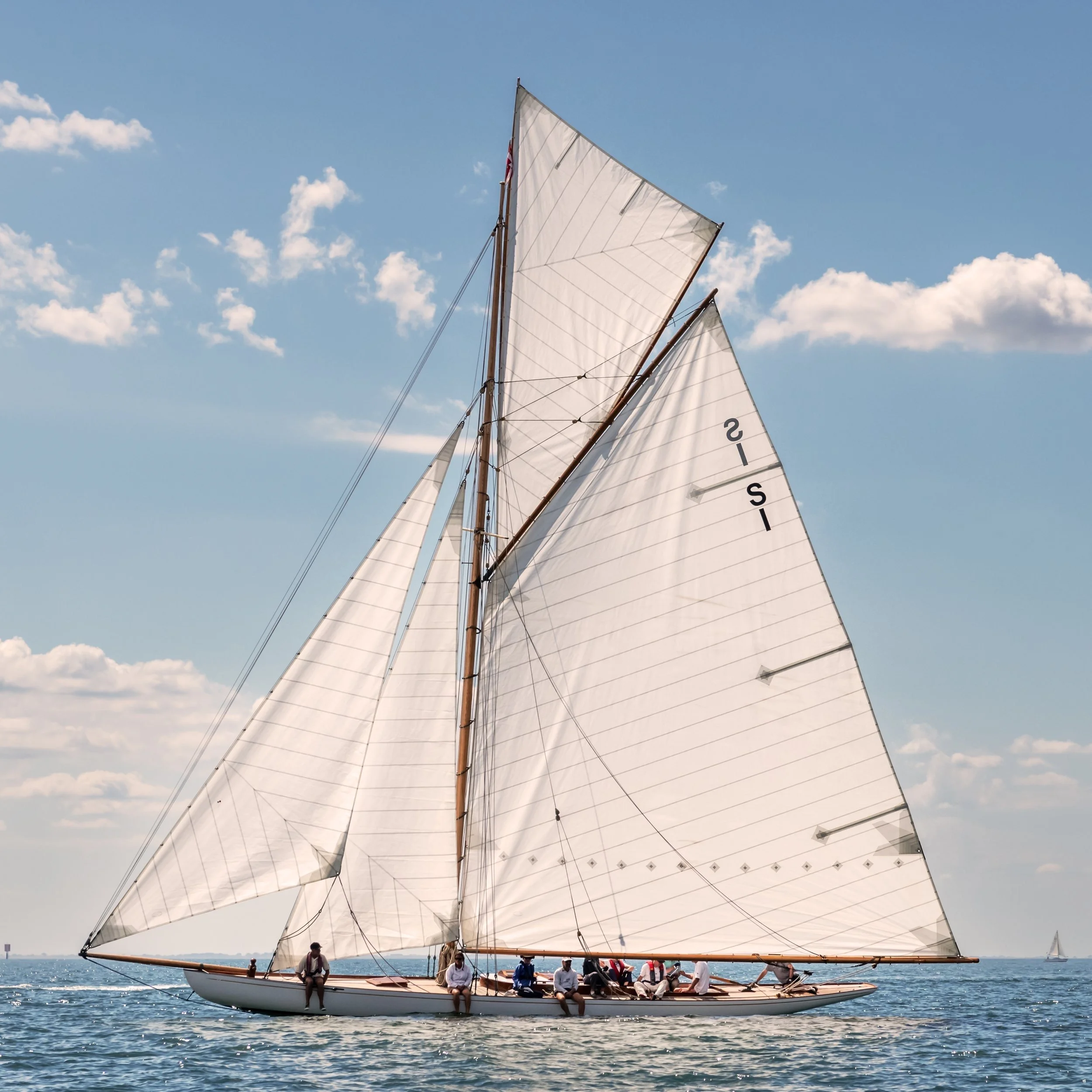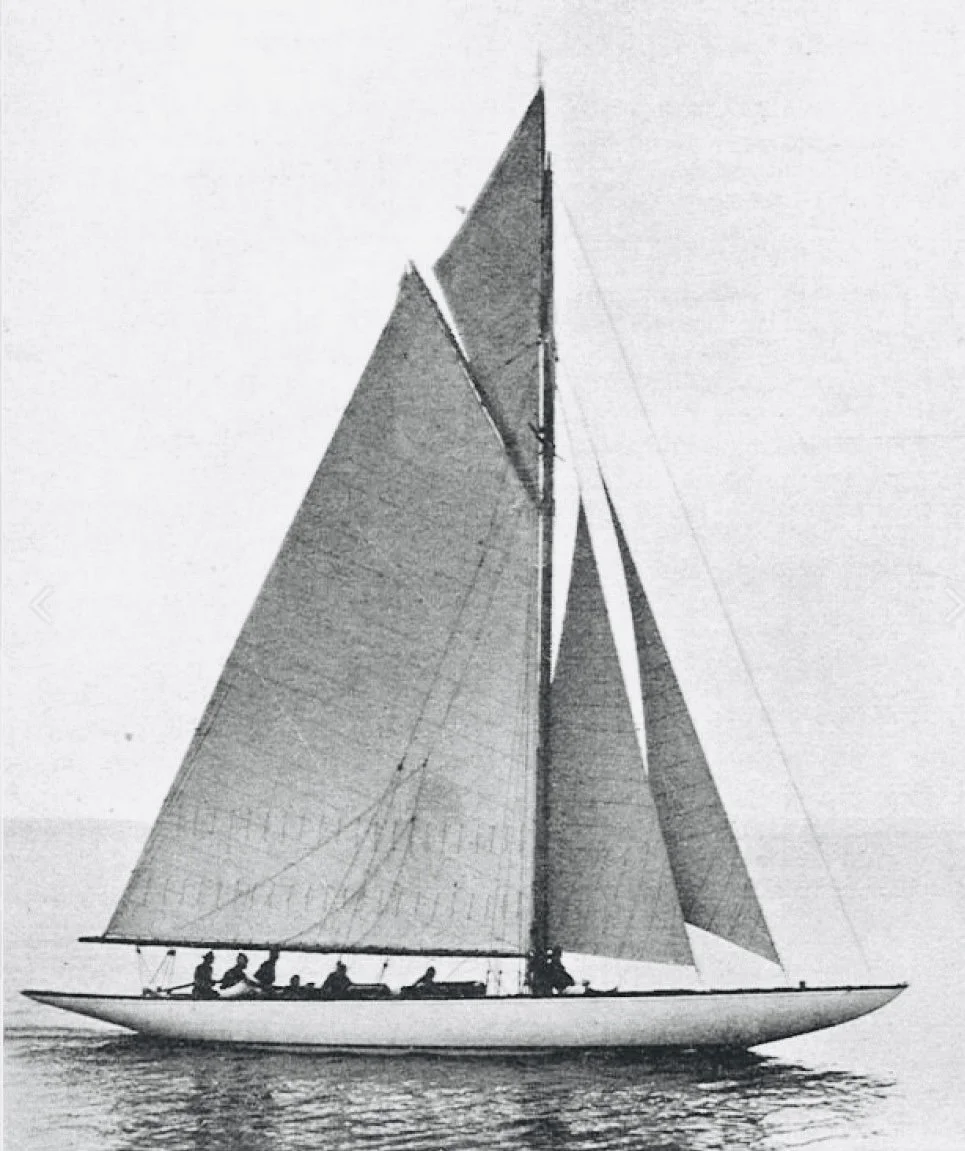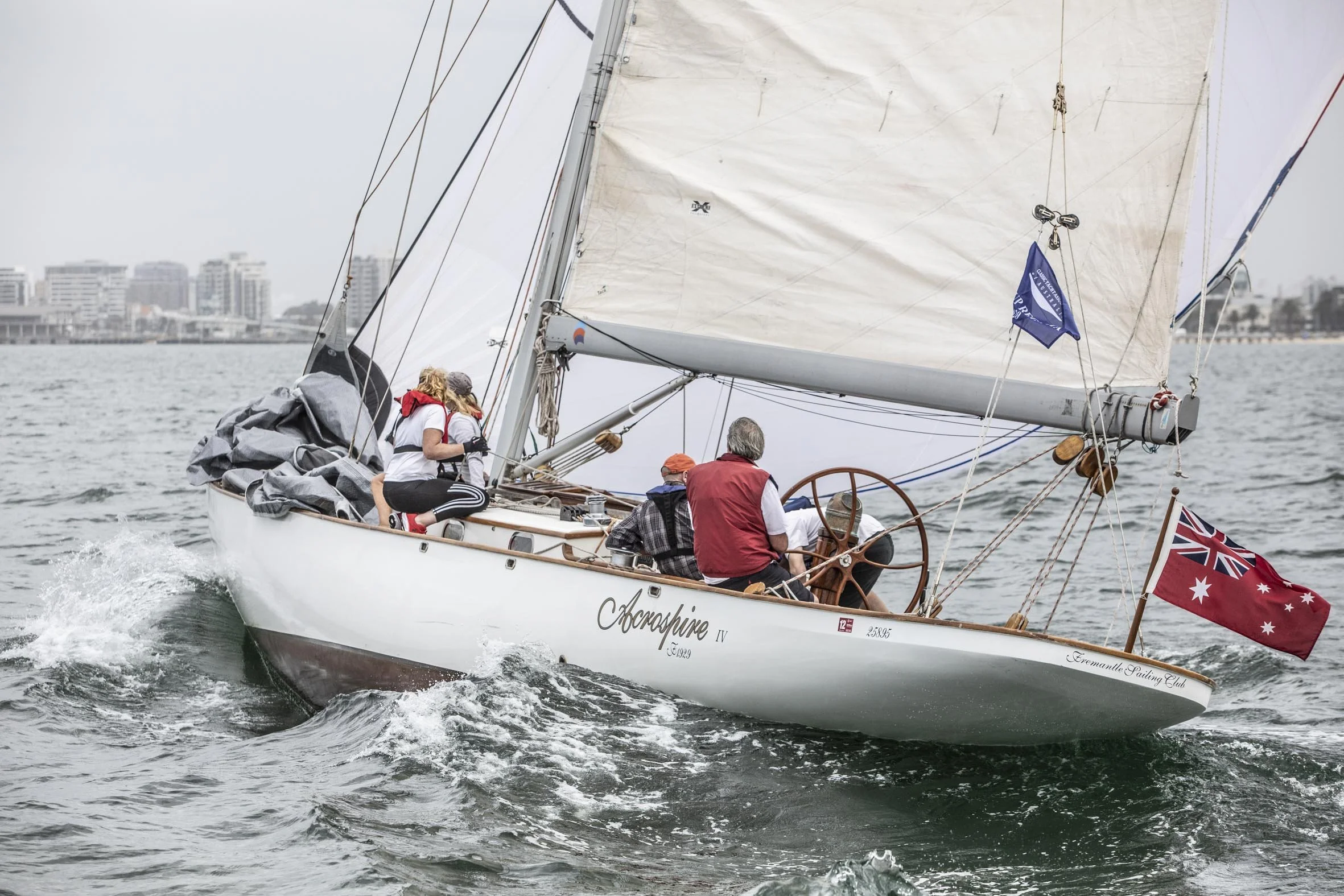Joe White Continues his Work
A bright future for Melbourne’s annual Cup Regatta has been secured with a generous sponsorship agreement between the Joe White Bequest and the Classic Yacht Association of Australia.
ACROSPIRE III. Photo Mark Chew
The Trustees of the Joe White Bequest have also established a trophy to honour the significance of Joe’s long contribution to yachting and yacht clubs in Victoria, notably at Lake Wendouree, Albert Park Lake and St Kilda on Port Phillip Bay. The trophy will recognise the efforts of men and women who restore, maintain, sail and race classic timber boats.Don’t settle for silver when a classic wooden floor is the Joe White Bequest Trophy at RYCV
Gold and Good Beer
Most classic yacht sailors will know the name Joe White, usually through his association with a line of five yachts all named ACROSPIRE. His story and the legacy he has left to Victorian yachting is more deep and generous than just a list of boats.
In a sense the story begins with rural Victoria’s gold rush in the 1850’s. Previously quiet regional centres saw a sudden influx of miners. Towns such as Ballarat were awash with men with a thirst for good fortune and good ale.
But the beer, was not of the high quality we associate with the brewing industry of today. Brewers had to rely on the timelines of sailing ships carrying malt from the other side of the globe. Joe White’s father Alexander, along with some colleagues, decided to provide a local alternative.
Alexander a trained maltster, joined forces with Henry Cane who had been malting in Ballarat since 1858. Under Alexander’s watch from 1888, Joe paid his dues at the malthouse. Like all new employees he would sweep the floors, feed the hoppers, operate the revolving screens then fill and sew-up the four and a half bushel bags. In 1892, only four years into Joe’s training, Alexander died. Joe at 23 stepped up and took the reins of the growing business. He thrived as a leader, and two years later, a new malthouse stood proudly on Gregory Street on the banks of Lake Wendouree.
ACROSPIRE I on Lake Wendouree ‘Will you come for a sail’ C1890. BYC Archive
Lake Sailing - ACROSPIRE I
Ballaarat Yacht Club was formed in 1877 thriving on the tailings of the mining boom. Sailing on Wendouree in the late 19C had an uneven start. The sport was dependent on changing personal and economic fortunes to build yachts and maintain a club, while long droughts meant variable water levels and weeds in the lake. By the late 1880’s BYC faltered with the economic downturn and unreliable management and membership.
In this hiatus the Ballarat Amateur Sailing Club was formed in 1888 with Alexander White as an office bearer. His sons Joe and Alexander started sailing on 16 and 18 foot skiffs. These were shallow draft, half deckers with names like WHITE SQUALL, CHANCE and FOAM. The Whites commissioned their own 16 footer and named her ACROSPIRE.
BYC restarted in 1890 with Lake Wendouree supporting two clubs until 1910. The clubs ran busy sailing programs with regular inter-club regattas on Lake Colac and Albert Park Lake in Melbourne. From 1900, it appears the Whites were involved with both clubs as successful sailors and office bearers. During the early 19C Federation, Ballarat was going through difficult times. Mining was in decline as were local foundries that supported the industry. In spite of drought and extensive hardship, Ballarat continued to promote itself as a cultural centre with carnivals focusing on family recreation and sailing on Lake Wendouree.
Joe’s lifelong interest to use his malting fortune to underwrite clubs and communities started early. In 1907, to secure Ballarat YC’s facilities he provided a bank guarantee of 150 pounds to purchase the Garden City Steamboat Company’s shed. The club leased back the facility for five guineas per annum. For comparison, annual membership was one guinea and students paid fifty shillings.
By 1910, BYC started to formulate sailing rules. stipulating that no yacht could sail in a club race that exceeded 25 foot length, 20 foot waterline and eight foot beam. This was of interest to Joe White in the following year when designing a new lake yacht.
16 & 18 foot skiffs or 'white wings' on Lake Wendouree. Postcard from BYC Archive
Lake Sailing - ACROSPIRE II
Like many competitive sailors, Joe was always looking for a yacht that was a little faster and more impressive than his current boat. In 1911 he approached Charlie Peel in Williamstown. Peel was well known for his inventive designs for the 21 foot Restricted Class. White commissioned a 25 foot ‘Unrestricted Class’ yacht that pushed the envelope as all good designers strive to do.
When the new boat first took to the water on Albert Park lake, the yacht caused a sensation because of her sleek lines and obvious speed. At the 1912 Colac Regatta, the Colac Herald reported;
‘Racing was uninteresting because a new ‘crack’ Ballarat boat won most races with margins exceeding five minutes. The yacht was Joe White’s ACROSPIRE II, a beautiful new white-hulled boat with a crimson waterline and a pink deck built by Mr Charles Peel’
After the last race a protest was lodged claiming ACROSPIRE II was 6 inches too long. Joe White and his crew refused a re-measure. A few weeks later Albert Park Yacht Club received a measurement certificate signed by White that did little to settle the matter. The yacht was 24’ 11’’ LOA with 18’ 6’’ LWL. APYC officials remained sceptical and an uneasy stalemate, fanned by gossip continued. Typically;
‘To get the boat to meet waterline length under 20 feet, it was necessary for two crew to sit on the bow while the measurement was taken’
Certificate of Rating signed by Joe White in 1912. APYC Archive
In 1914, during the First World War, Joe White moved to Melbourne to expand the malting business in Collingwood. He brought ACROSPIRE II with him joining Albert Park YC. He soon had his eye on a bigger boat and sold her to the Treasurer at the club where she continued lake sailing. After the easter regatta in 1915 most inter-club events were suspended for the war years. ACROSPIRE II returned to Ballarat in 1927 as the BYC club boat. Sadly, Joe’s brother and sailing companion, Lt Col Henry Alexander White of the Light Horse, was killed at Gallipoli in 1915 leading a charge at the Battle of the Nek.
In 1971 ACROSPIRE II was offered for sale in Ballarat. In very poor shape, members returned her to Albert Park YC. She was just sailable and led the sail past at the Centenary Opening Day that year. In 1977 club volunteers fully restored her to racing condition with new ribs, frames and plank patching. She was then fully re-caulked and painted in her original colours. In White style, Mr Hilton White, Joe’s younger brother donated to the project to cover the transport costs.
The photo above is ACROSPIRE II being unloaded at APYC in 1971. ‘Her clean well proportioned lines are apparent. The centreboard is shown fully extended revealing the limited lateral resistance possessed by lake boats’. This would make her lively to handle sailing in any swell and chop on Port Phillip Bay. Photo: Ralph Neale Archive, APYC.
ACROSPIRE II led the fleet again for the APYC Sesquicentennial celebrations in 2021. She now sits on her mooring as the ‘flag ship’ for the club. Almost fifty years has past since this first restoration. Once again she’s in need of refurbishment by a new generation of boat builders and sailors willing to keep her important legacy alive.
Peter Costolloe, Race Director of the CYAA, remembers ACROSPIRE II’s performance against the Classic and Couta boats during the Volvo Regatta on Port Phillip Bay in 2005.
She’s really a lake boat but absolutely cleaned-up the classic fleet with a ballasting pile of older experienced Albert Park sailing types on board. This low slung thing had the right shape for lighter conditions with small chop on Port Phillip. She absolutely streaked away from the fleet on both mornings.
The restored ACROSPIRE II on Albert Park Lake 1979. APYC Archive
It’s unclear when Joe White made the move to St Kilda YC. In 1914 Joe purchased another Charlie Peel speedster, the 36ft centre-boarder THERA, to sail on Port Phillip Bay. She was essentially the big sister to ACROSPIRE II and a handful in open water with her shallow draft. Unlike most boats of the era with long deep keels, she relied on ‘live ballast’ of up to nine crew stacked on the windward gunwale. Other boat owners tried to exclude her from competition and the Victoria Yacht Racing Association moved her to the A Class. Here she continued winning races taking line honours and handicap. She was so controversial, the owners agreed not to accept trophies ….for a while. THERA has been restored and sails from Royal Perth YC on the Swan River in WA.
THERA sailing on Port Phillip Bay around 1913
The Acrospire
Through this beautiful boat name, Joe White’s business and sailing life became intrinsically linked. It has also proved to be a well regarded legacy in the Australian sailing community.
The acrospire is the sprout that emerges from a grain of barley seed as it begins to germinate during the malting process. It’s an indicator of the progress and quality of malting, closely monitored to ensure the right degree of modification has been achieved before the malt is used for brewing.
The Sayonara Cup - ACROSPIRE III
This is Australia’s equivalent of the America’s Cup. It was the premier race between interstate yachts with challenges mainly coming from Sydney and Melbourne. The first challenge held in Sydney in 1904, was won by SAYONARA from Melbourne beating BONA in best of three races. SAYO held the cup for many years against various NSW challenges. For more on the Sayonara Cup see SWS ‘A 1955 Viewpoint’ from 2023.
From 1928 Joe White challenged three times in Sydney with his ACROSPIRES. The event had not been raced since 1910 when SAYONARA beat CULWULLA III twice in best of three races on Port Phillip. Similar to the skullduggery that later plagued the Americas Cup, the teams could not agree on correct ratings and time allowances. They decided to sail off scratch and submit their handicap claims for adjudication to the Yacht Racing Assoc. of England. A few months later the YRA determination arrived. SAYONARA was a 12m and CULWULLA III a 10m. Royal Sydney YS took the cup home. The enthusiasm for a challenge to return the cup to Melbourne was tempered when SAYONARA, the champion Victorian yacht, was purchased by a member of RSYS.
By the 1920’s, Joe White was Vice Commodore of the Royal St Kilda Yacht Club and a prominent yachtsman in Victoria. We might presume that the club looked to White, an experienced builder and industrialist, for advice while constructing their new clubhouse. The building we know today on the St. Kilda foreshore was opened in 1926.
Looking for the right design for a successful Sayonara Cup challenge, White again visited Charlie Peel who was working in Sydney at J Hayes and Sons in Careening Cove. The result was ACROSPIRE III, a 50ft gaff cutter, carvel planked in New Zealand kauri. She was built in 1923 and shipped to Melbourne in early 1924 aboard the SS ECHUNGA.
ACROSPIRE III at RYCV 2021. Photo Charlie Salter
Long, low & lean ACROSPIRE III. Photo Mark Chew
ACROSPIRE III was designed to rate as an 8 metre and match with the likely NSW defender. However in trials, her construction proved too light for the rough conditions on Port Phillip and the challenger’s handicap of an ocean voyage to Sydney. Peel recommended she be strengthened thereby adding weight. The result was that the yacht sat lower in the water than intended by the design. With a longer waterline, she ended up rating just under 9 metres.
The rules required the Sayonara challenger to sail to the cup holders home port ‘on her own keel’. Departing Williamstown on Boxing Day 1927, White sailed ACROSPIRE III for Sydney. They ran before a southerly gale from outside Port Phillip heads then turned the corner at Gabo Island where the weather worsened. After 50 hours non-stop, with a near loss of crew overboard, they found shelter at Ulladulla on the NSW south coast. Ernie Digby was in that crew. He was the designer and builder of two Melbourne 8 metre yachts DEFIANCE and FRANCES, both still sailing today. Digby won the Sayonara Cup for RYCV with FRANCES three times in 1951, ‘52 and ‘54.
Melbourne's Sun Pictorial January 1928. RMYS Archive
With expectation of a serious Victorian challenge, the Albert family of Royal Sydney Yacht Squadron imported VARG from England for some 2,500 pounds. They renamed her NORN. She was an International 8m designed and built in 1924 by the Norwegian Johan Anker, later famous for the Dragon. Int. 8m designs were well established and refined, having been an Olympic class since London in 1908. For interest, the Albert family lived at Boomerang fronting Elizabeth Bay. They made their money from music with piano sales, music publishing and recording studios. They launched the careers of the Easybeats in the 1960’s and later AC/DC, bands built around gifted English migrants.
Charlie Peel’s design was quite different being a long, low and lean pole-masted cutter, carrying mainsail, topsail, staysail and jib. Her sail-plan was longer at the foot, but not so lofty as the Bermudan rigged defender NORN. She was still a speedster but rated at 8.83 metres compared to NORN at 8.03 metres, giving the Sydney yacht a time allowance of 21.6 seconds per mile. ACROSPIRE III would concede more than 7min over a 21 mile course.
The first race was sailed in a NE breeze, and ACROSPIRE III gradually took the lead on the beat to be 3 minutes ahead at the windward mark, increasing this to 4 minutes at the finish. This was not enough to win on handicap, and NORN’s rating advantage gave it a win by over 3 minutes. The second race was sailed in light conditions, and NORN took the lead when the southerly turned towards north east during the second leg and it was better placed to pick up the new breeze. ACROSPIRE III made up some ground on the final leg as the breeze freshened, but NORN ended up winning by a huge margin of just over 23 minutes. NORN’s simpler rig proved more capable in the variable winds. She won the first two races making a third unnecessary.
Even with some post race dispute over NORN’s measurement and rating, Joe White accepted the beating. He returned to St Kilda determined to challenge again with a larger craft. White knew the success of International 8m designs well, but preferred to commission and work with Charlie Peel to design his new challenger. Melbourne newspapers reported;
‘White was out to demonstrate that in Port Phillip there are boats speedier than in other parts of the Commonwealth, and that Sydney Harbour amateurs are not the equal to those who specialise in the choppy water off the Gellibrand’.
ACROSPIRE III at Geelong WBF 2022. Smeaton Photography
ACROSPIRE III has been beautifully restored by Col Anderson. Col is one of Melbourne’s outstanding helmsman and sailmakers. Always looking for an edge the traditional standing rig has been recently changed to Dyneema. Joe White would certainly have approved. This much admired yacht still sails regularly as the back-marker in CYAA races and regattas.
Tumlare One-design
Let’s leave the ACROSPIRE story for a moment and consider another yacht design that led to Victoria’s most successful keelboat. This was Joe White’s YVONNE #97.
In 1937 the Royal St Kilda YC, now RMYS, were looking for a one-design class suitable for Port Phillip Bay. Commodore Joe White convened a meeting with a delegation from Royal South Australia YS, headed by boatbuilder Mr P. Clausen. On the night, the Tumlare class from the Stockholm designer Knud Reimers was unanimously adopted and it was agreed that 6 yachts would be built for the 1937-38 season. Two orders were placed with Clausen and two each with Jack Savage and Charlie Peel.
Clausen’s had ACKLOREAN #98 and TARNA #91 ready for launching in Victoria for the 1937-38 season. Savages built ZONJA #92 and AVIAN #96 and Charlie Peel had YVONNE #94 and ZEST #99 ready for the season start. GOTNUM #93, the 7th boat was built using Peel moulds and launched in early 1938.
In the first sailing season Joe White sold his YVONNE to a young Don Banks who renamed her DOFFIE. To expand the class, White ordered another yacht from Charlie Peel retaining the name YVONNE #97 after his daughter. She was ready for the 1938-39 season. He also underwrote several yachtsmen with loans to pay for licenses and completion of their orders.
Skippered by Alick Rose, YVONNE #97 proved to be fast, winning the first two races of the season. By 1949, White had put her in the capable hands of Selim Nurminen. Over twenty-one seasons from 1955 to 1976 Selim was rarely out of the placings in club racing. He won 17 Victorian State Championships in YVONNE. Many of these early Tumlaren are still sailing and several will be showing off at the Cup Regatta this November
This interest in other classes apart from the ACROSPIRE dynasty is typical of White’s commitment to yachting in Victoria. He didn’t often sail on his Tumlaren but saw that success of a one-design class was critical to the health and activity of his club. This personal effort matched with generous funds built a sailing legacy that is well recognised to this day.
With her history of success on Port Phillip, YVONNE #97 was brought home from Adelaide in 2016 and fully restored. Many of these early Tumlaren are still sailing and will be competing in the Cup Regatta this November.
Joe White’s YVONNE after relaunch 2022. Photo: Charlie Salter
Beer vs Biscuits - ACROSPIRE IV
Even with a post race dispute over NORN’s measurement and rating, Joe White was sportsmanlike and accepted the loss. He returned to St Kilda determined to challenge again with a larger craft. White knew the success of International 8 metre designs coming from Scotland and Scandinavia, but preferred to commission and work with Charlie Peel to design his new challenger for the Sayonara Cup. Local newspapers reported;
‘Maltster Joe White Builds a Fine Craft at Collingwood.
‘Where there’s a will there’s a way’. This has been a life’s slogan of Mr Joe White, an emperor among maltsters all over the Commonwealth, a prince among yachtsmen who use the waters of Port Phillip, and an employer who has always shown kindly spirit among his many hundreds of employees. Mr White kept his intentions to himself for some time, and ‘Truth’ has learned that a new vessel is now under construction in the yards of the malting works at Collingwood’.
While ACROSPIRE IV was being built in 1929, VANESSA another new International 8 metre designed by William Fife and commissioned in Sydney by the Arnott biscuit family successfully defended the cup against Victoria’s EU-NA-MARA from RYCV.
Peel and fellow shipwright Jack Gutierrez built ACROSPIRE IV in a shed adjacent to Joe White’s malthouse in Collingwood. The hull was 16.3m, planked in Kauri on Blackwood frames. It was rigged as a gaff cutter with spruce spars and rated 9.25 metres. The choice of a gaff rig was unusual as the NSW yachts had been using the more modern Bermuda rig plans since the mid-1920s. However the Australian Motor Boat & Yachting Monthly magazine reported in 1929 ‘that the yacht could be easily changed to the newer rig if the topsail gaff is not satisfactory’.
Moving the yacht from Collingwood to the water was a challenge, accomplished overnight with the yacht in a solid cradle on a timber jinker It was craned into the Yarra River from the North Wharf near Docklands on the morning of 17th October 1929.
ACROSPIRE IV with her topsail rig after launch in 1929
ACROSPIRE IV after changing to her Bermudan rig
The first trials on Port Phillip went well and ACROSPIRE IV sailed north at the end of 1929 for the challenge races scheduled to begin in mid-January 1930. It was to be a best of five races. Once again the defender was the Arnott’s well proven 8 metre VANESSA against ‘the persistent Mr White’ as RSYS condescendingly records. This suggests they were nervous about the new Peel yacht.
ACROSPIRE IV was the larger boat rating 9.31 metres. She was no match for the well sailed VANESSA from RSYS assisted by her considerable handicap advantage. The Sayonara Cup was successfully defended in three straight victories.
Leaving the yacht in Sydney, Joe White kept faith with his boat and malting business during these depression years. Perhaps beer was recession proof. He changed to the alternative Bermudan rig and increased the sail area to 1,200 square feet in an attempt to gain more speed for another challenge in 1931. After a measure, ACROSPIRE IV’s handicap increased further giving VANESSA 29.9 seconds per mile. There was frustratingly no marked improvement to the challenger’s boat speed.
VANESSA won the first and second races of the series without need of her time allowance. ACROSPIRE IV crossed the finish line only 31 seconds ahead in the third race, not nearly enough to overcome the time allowance of 9 minutes 58 seconds on that course. The defender had retained the cup for the Sydney Squadron. It was well noted that the same Sydney skipper had defended four times. Charlie Trebeck helmed NORN in 1928 and then VANESSA in 1929, 1930 and 1931. He was the Bus Mosbacher and Dennis Connor of his era.
The final submission to the dominant 8 metre yachts was VANESSA being purchased by a Melbourne Syndicate from RYCV who returned to challenge in 1932. They successfully brought the Sayonara Cup back to Victoria after defeating NORN in close match racing off similar ratings.
The Sayonara Cup challenge was not run again until 1951 when Williamstown shipwright Earnest Digby defended two years running in his own 8 metre FRANCES. Digby must have caught the bug from Joe White, being in the crew on ACROSPIRE III for the 1928 challenge. FRANCES has been sailing with the Melbourne Classic fleet for many years. VANESSA remains at the Royal Yacht Club Victoria and is now being restored in Ferdi Darley Traditional Shipwright’s shed in Williamstown.
Following the death of Joe White in 1959, ACROSPIRE IV was sold to a syndicate from RYCV with the expressed intention of training Victorian crews for America’s Cup challenges. She was sold to Western Australia in 1971, and then returned to Sydney in 2022 where she now races with the Sydney Amateur Sailing Club.
ACROSPIRE IV sailing in Melbourne in recent years
A Missing 6 Metre - ACROSPIRE V
In 1934 the final ACROSPIRE V was built by Charlie Peel. This is an International 6 metre based on TOOGOOWOOLOO II from a design by the celebrated William Fife III of Scotland. Little is known of her whereabouts now. What we do know is that she was built alongside JUDITH PIHL another Peel 6 metre and we assume her design to be similar. Peel used his favoured timbers seen on YVONNE of huon pine planking over spotted gum frames. Like his patron Joe White, Charlie named the boat after his daughter. Pihl is the original European spelling of the family name.
RYCV race records from 1935 for the 6 Metre Class McCutcheon Cup show JUDITH PIHL with sail number S13 and ACROSPIRE V with S6. By 1939 S6 is renamed WHITE WINGS a common moniker for lake boats from the turn of the century.
It seems White’s interest was similar to the St Kilda Tumlaren. That is to develop a competitive one-design fleet in each state based on a long standing Olympic class. The 6 metres raced in Australia for the Northcote Cup, a well followed interstate challenge.
JUDITH PIHL after restoration, sailing in Sydney. Australian National Maritime Museum
The Acrospire Story
Written by Mark Chew & Charlie Salter with archive research by Peter Costolloe of the CYAA.
Sources
Ballaarat Yacht Club 1877 - 2002. Dr Peter Mansfield. Published by BYC 2002
APYC, 150 Years on the Lake. Christopher J Davey. Published by APYC 2021
Sydney Sails. Royal Sydney Yacht Squadron 1862 - 1962. P R Stephensen. Published by Angus & Robertson 1962
Archive of Royal Melbourne Yacht Squadron
Joe White Bequest Trophy 2024
The Joe White Bequest Trophy will be designed to reflect the quality and craftsmanship of a classic wooden sailing or motor boat. It will be awarded at the Classic Yacht Association Cup Regatta 2024 by an independent judge from interstate or overseas accompanied by the Chair of Trustees. Judging will be at RYCV on Saturday morning 1 November and the trophy presented after racing on Sunday 2 November.
Yachts and Boats entered in the Regatta will be automatically entered into this concours.
Entries and information about the 2024 Cup Regatta can be found HERE
Royal Melbourne Yacht Squadron Archive



